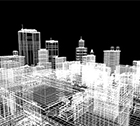
It’s received wisdom that the famous 1963 blockbuster, Cleopatra, was such a flop it brought the era of Hollywood 70 mm epic dramas to an end and almost killed off Twentieth Century Fox.
However as Michael Woods points out, the film was actually a great success with audiences and took a lot of money at the box office. The problem was it simply “cost too much – way too much – to make”.
Australian cities face their own ‘Cleopatra Problem’ as they attempt to deal with growth. Part of the difficulty is new transport infrastructure generally only produces a modest stream of benefits (as discussed here and here), but the key issue is the cost of construction – it’s staggering.
For example, stage one of the East-West Link freeway tunnel in Melbourne’s inner city is estimated to cost $6-8 billion. The proposed Melbourne Metro rail tunnel under the CBD is costed at $9 billion and the mooted rail line from suburban Doncaster to the CBD is estimated to cost $7-12 billion.
With capital outlays of this order of magnitude, it’s very hard to get a positive benefit-cost ratio from what are necessarily marginal additions to mature networks.
Some observers argue that governments and transport authorities conspire to inflate cost estimates. While there are always exceptions, I think as a general proposition that’s rubbish. On balance, the direction of incentives runs the other way i.e. to under-estimate costs.
Bent Flyvbjerg from Oxford University’s Saïd Business School says cost overruns in the order of 50% in real terms are common for major infrastructure projects and overruns above 100% are not uncommon.
Professor Flyvbjerg examined 258 transport projects in 20 nations over a 70 year time frame and found the average cost overrun for rail projects is 44.7% measured in constant prices from the build decision. For bridges and tunnels, the equivalent figure is 33.8%, and for roads 20.4%.
This is a problem that afflicts a number of countries, most especially Anglophone ones. Projects are costed by experts who know the business. It makes little sense to pretend it’s all a fabrication (although there’s a political advantage of course in pretending).
The key priority should be to address whatever it is that’s inflating infrastructure costs in Australia.
It’s an issue I’ve discussed a number of times before. Here’s a crowd-sourced list of 43 possible causes of high transport infrastructure costs. No one seems to know the answer – it’s hard to pin down the prime causes because there’s so much variability between ostensibly similar projects.
I think the list of key suspects in the Australian context must include the effects of the infrastructure boom, the ascendancy of private-public partnerships, and the increasing inclination of politicians to reflexively accommodate the demands of special interest groups. Contrary to the mythology around urban consolidation, retro-fitting infrastructure within established areas also inflates costs.
Unless infrastructure costs can be reduced significantly, any long-run urban strategy that depends heavily on building big-ticket items like rail lines and freeways will be very hard to achieve even if governments are prepared to borrow more aggressively.
Political pressure might work on occasions but it won’t be enough when there are underlying structural forces inflating costs. In any event, political battles are more likely to deliver boondoggles than projects with real benefits.
The scale of works required to effect significant change in our metropolitan areas shouldn’t be underestimated. For example, the report on Doncaster rail says the line would produce a “negligible” mode shift from car to train. Modelling indicates the mooted Rowville rail line would yield a trivial reduction in car travel by 2046.
This isn’t solely a problem of governments not borrowing enough. I’d like to suggest to the Prime Minister and the Leader of the Opposition that they commit to a high profile inquiry into the ‘Cleopatra Problem’. It should be public and it should have the resources to undertake its own technical investigations of the cost of transport infrastructure, not simply adjudicate submissions from lobby groups.
A vigorous public debate might help to restrain further cost increases and possibly even lead to real reductions at the margin. That alone would justify an inquiry. However barring an economic catastrophe I don’t think the ‘Cleopatra Problem’ is going away. We’re not likely to see a return to the costs of 7-10 years ago.
Governments need to borrow, charge and tax more to build infrastructure, but they’ve also got to look at ways of making existing infrastructure assets such as rail lines and roads work harder. The days of supporting easy practices like under-pricing travel and continuously expanding infrastructure appear to be gone.
It’s the responsibility of politicians to convince the electorate of the need for a new approach. Policies such as congestion pricing are required to obviate or delay construction of freeways. They need to step up and pursue initiatives like requiring motorists to give up road space for dedicated frequent bus networks connecting with the existing rail system.
It’s likely there’ll always be a need from time-to-time for some new major infrastructure projects despite the high cost (e.g. Melbourne Metro), but it’s doubtful if building big projects can continue to be the key transport strategy for our cities. A smarter (albeit harder) approach is required.








Crikey is committed to hosting lively discussions. Help us keep the conversation useful, interesting and welcoming. We aim to publish comments quickly in the interest of promoting robust conversation, but we’re a small team and we deploy filters to protect against legal risk. Occasionally your comment may be held up while we review, but we’re working as fast as we can to keep the conversation rolling.
The Crikey comment section is members-only content. Please subscribe to leave a comment.
The Crikey comment section is members-only content. Please login to leave a comment.